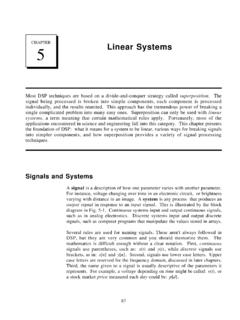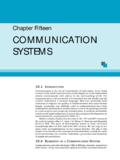Transcription of The fundamentals of millimeter wave - TI.com
1 The fundamentals of millimeter wave sensorsCesar IovescuRadar Applications ManagerSandeep RaoRadar Systems ArchitectTexas InstrumentsThe fundamentals of millimeter wave sensors 2 May 2017 IntroductionMillimeter wave (mmWave) is a special class of radar technology that uses short-wavelength electromagnetic waves . Radar systems transmit electromagnetic wave signals that objects in their path then reflect. By capturing the reflected signal, a radar system can determine the range, velocity and angle of the radars transmit signals with a wavelength that is in the millimeter range. This is considered a short wavelength in the electromagnetic spectrum and is one of the advantages of this technology. Indeed, the size of system components such as the antennas required to process mmWave signals is small.
2 Another advantage of short wavelengths is the high accuracy. An mmWave system operating at 76 81 GHz (with a corresponding wavelength of about 4 mm), will have the ability to detect movements that are as small as a fraction of a complete mmWave radar system includes transmit (TX) and receive (RX) radio frequency (RF) components; analog components such as clocking; and digital components such as analog-to-digital converters (ADCs), microcontrollers (MCUs) and digital signal processors (DSPs). Traditionally, these systems were implemented with discrete components, which increased power consumption and overall system cost. system design is challenging due the complexity and high Instruments (TI) has solved these challenges and designed complementary metal-oxide semiconductor (CMOS)-based mmWave radar devices that integrate TX-RF and RX-RF analog components such as clocking, and digital components such as the ADC, MCU and hardware accelerator.
3 Some families in TI s mmWave sensor portfolio integrate a DSP for additional signal-processing devices implement a special class of mmWave technology called frequency-modulated continuous wave (FMCW). As the name implies, FMCW radars transmit a frequency-modulated signal continuously in order to measure range as well as angle and velocity. This differs from traditional pulsed-radar systems, which transmit short pulses fundamentals of millimeter wave sensors 3 May 2017 Range measurementThe fundamental concept in radar systems is the transmission of an electromagnetic signal that objects reflect in its path. In the signal used in FMCW radars, the frequency increases linearly with time. This type of signal is also called a chirp. Figure 1 shows a representation of a chirp signal, with magnitude (amplitude) as a function of 2 shows the same chirp signal, with frequency as a function of time.
4 The chirp is characterized by a start frequency (fc), bandwidth (B) and duration (Tc). The slope of the chirp (S) captures the rate of change of frequency. In the example provided in Figure 2, fc = 77 GHz, B = 4 GHz, Tc = 40 s and S = 100 MHz/ FMCW radar system transmits a chirp signal and captures the signals reflected by objects in its path. Figure 3 represents a simplified block diagram of the main RF components of an FMCW radar. The radar operates as follows: A synthesizer (synth) generates a chirp. The chirp is transmitted by a transmit antenna (TX ant). The reflection of the chirp by an object generates a reflected chirp captured by the receive antenna (RX ant). A mixer combines the RX and TX signals to produce an intermediate frequency (IF) frequency mixer is an electronic component that combines two signals to create a new signal with a new two sinusoidal inputs x1 and x2 (Equations 1 and 2):(1)(2)The output xout has an instantaneous frequency equal to the difference of the instantaneous frequencies of the two input sinusoids.
5 The phase of the output xout is equal to the difference of the phases of the two input signals (Equation 3):(3)The operation of the frequency mixer can also be understood graphically by looking at TX and RX chirp frequency representation as a function of upper diagram in Figure 4 on the following page shows TX and RX chirps as a function of time for a single object detected. Notice that the RX chirp is a time-delay version of the TX 1 & 21t t f fc = 77 GHz 81 GHz Tc = 40 s A B = 4 GHz S Figure 1. Chirp signal, with amplitude as a function of 1 & 21t t f fc = 77 GHz 81 GHz Tc = 40 s A B = 4 GHz S Figure 2. Chirp signal, with frequency as a function of signalSynthTX 3. FMCW radar block 2 shows the same chirp signal, with frequency as a function of time.
6 The chirp is characterized by a start frequency (fc), bandwidth (B) and duration (Tc). In the example provided in Figure 2, fc = 77 GHz, B = 4 GHz and Tc = 40 s. Figure 2. Chirp signal, with frequency as a function of time. An FMCW radar system transmits a chirp signal and captures the signals reflected by objects in its path. Figure 3 represents a simplified block diagram of the main RF components of a FMCW radar. The radar operates as follows: A synthesizer (synth) generates a chirp. The chirp is transmitted by a transmit antenna (TX ant). The reflection of the chirp by an object generates a reflected chirp captured by the receive antenna (RX ant). A mixer combines the RX and TX signals to produce an intermediate frequency (IF) signal.
7 Figure 3. FMCW radar block diagram. A frequency mixer is an electronic component that combines two signals to create a new signal with a new frequency. For two sinusoidal inputs x1 and x2 (Equations 1 and 2): 1=sin ( 1 + 1) (1) 2=sin ( 2 + 2) (2) The output xout has an instantaneous frequency equal to the difference of the instantaneous frequencies of the two input sinusoids. The phase of the output xout is equal to the difference of the phases of the two input signals (Equation 3): =sin[( 1 2) +( 1 2)] (3) The operation of the frequency mixer can also be understood graphically by looking at TX and RX chirp frequency representation as a function of time. Figure 2 shows the same chirp signal, with frequency as a function of time.
8 The chirp is characterized by a start frequency (fc), bandwidth (B) and duration (Tc). In the example provided in Figure 2, fc = 77 GHz, B = 4 GHz and Tc = 40 s. Figure 2. Chirp signal, with frequency as a function of time. An FMCW radar system transmits a chirp signal and captures the signals reflected by objects in its path. Figure 3 represents a simplified block diagram of the main RF components of a FMCW radar. The radar operates as follows: A synthesizer (synth) generates a chirp. The chirp is transmitted by a transmit antenna (TX ant). The reflection of the chirp by an object generates a reflected chirp captured by the receive antenna (RX ant). A mixer combines the RX and TX signals to produce an intermediate frequency (IF) signal.
9 Figure 3. FMCW radar block diagram. A frequency mixer is an electronic component that combines two signals to create a new signal with a new frequency. For two sinusoidal inputs x1 and x2 (Equations 1 and 2): 1=sin ( 1 + 1) (1) 2=sin ( 2 + 2) (2) The output xout has an instantaneous frequency equal to the difference of the instantaneous frequencies of the two input sinusoids. The phase of the output xout is equal to the difference of the phases of the two input signals (Equation 3): =sin[( 1 2) +( 1 2)] (3) The operation of the frequency mixer can also be understood graphically by looking at TX and RX chirp frequency representation as a function of time. The fundamentals of millimeter wave sensors 4 May 2017 The time delay (t) can be mathematically derived as Equation 4:(4)where d is the distance to the detected object and c is the speed of obtain the frequency representation as a function of time of the IF signal at the output of the frequency mixer, subtract the two lines pre sented in the upper section of Figure 4.
10 The distance between the two lines is fixed, which means that the IF signal consists of a tone with a constant frequency. Figure 4 shows that this frequency is St. The IF signal is valid only in the time interval where both the TX chirp and the RX chirp overlap ( , the interval between the vertical dotted lines in Figure 4).The mixer output signal as a magnitude function of time is a sine wave, since it has a constant initial phase of the IF signal (F0) is the difference between the phase of the TX chirp and the phase of the RX chirp at the time instant corresponding to the start of the IF signal ( , the time instant represented by the left vertical dotted line in Figure 4). (Equation 5):(5)Mathematically, it can be further derived into Equation 6:(6)*In summary, for an object at a distance d from the radar, the IF signal will be a sine wave (Equation 7), then:(7)**whereThe assumption so far is that the radar has detected only one object.















